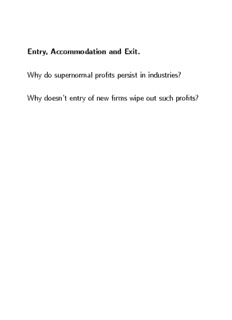
Entry, Accommodation and Exit. Why do supernormal profits persist in industries? PDF
Preview Entry, Accommodation and Exit. Why do supernormal profits persist in industries?
Entry, Accommodation and Exit. Why do supernormal profits persist in industries? Why doesn’t entry of new firms wipe out such profits? Harvard school of IO economists (Joe Bain): barriers to entry. Bain: a barrier to entry is anything that allows incumbents to enjoy strictly positive economic profits without threat of entry. These may include government regulation-permits, licenses, patents etc. - but we shall abstract from these. Bain argued there are four major types of entry barriers: 1. Economies of Scale (fixed cost): If minimum efficient scale is large relative to market demand, there can only be few firms in the market (e.g., natural monopoly) & they may earn strictly positive profit without inviting entry. 2. Absolute Cost Advantages: of incumbents (superior technology, previous capital accumulation, firm specific learning etc.) 3. Product Differentiation Advantages: Incumbents may have patented product innovations & cornered important niches in the product space, dynamic investment in forming consumer loyalty.... 4. Capital requirement: imperfect capital market, entrants may find it more diffi- cult or costly to raise capital. The Chicago school led by George Stigler approached en- try barriers as simply being cost asymmetries between incumbent firms and outsiders (incumbents could charge price above average cost because outside firms had higher average cost curves) . Traditional model of entry barrier by incumbent firms: Limit pricing model by Sylos-Labini, Modigliani etc.: Incumbent prices low enough so that outside firms cannot enter. This theory suffers from a credibility problem. Why would potential entrants believe that incumbents would hold on to those low prices if entry occurred? Not subgame perfect. Modern version: Spence (1977) - Dixit (1979,1980) Model: Capacity choice used as a credible precommit- ment to flooding market & low prices.
Description: